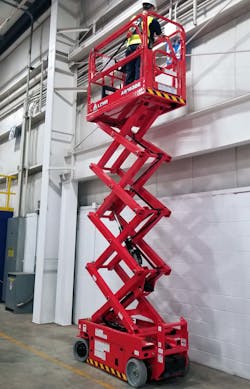RER Interviews Craig Paylor and Jordan Cuadrado, LGMGNA
RER interviews Craig Paylor – president, LGMG North America and Jordan Cuadrado – product manager, LGMG North America about new indoor/outdoor requirements and load-sensing triggers; and the resurgence of independent rental companies.
RER: What have you done to change your equipment technologically to prepare it to be compliant with the ANSI new standards?
Paylor, Cuadrado: We have defined indoor and outdoor requirements for all of our lifts using the 28 MPH wind speed calculation, installed overload sensing, added folding rails due to the increased rail height, and updated our operation service manuals.
For people who have not been following the ANSI changes, can you sum up how your equipment will change on a practical jobsite level – in other words, what will the customer find different?
The customer will immediately discover the indoor/outdoor requirements for each lift. Some will be indoor only and some will be outdoor with capacity restrictions. The customer now has to pay extra attention when requesting equipment to make sure they get the proper lift for the required job.
Another difference the customer will find is the overload sensing capabilities. The new ANSI standards will prevent all movement during overload above 1 meter or 10 percent of the lift’s maximum height. It will immediately stop operation if overloading is triggered – this will force the operator to know how much is on the platform at all times to prevent the overload sensor from triggering.
For rental people, how will their responsibilities change with the new ANSI standards?
Though it is generally always required, annual inspections now must be documented at all times. The owners of the equipment aka, “the rental people” must keep a record of the said inspections. Those renting the equipment are now required to do their due diligence in making sure the equipment they are renting out is up-to-date, otherwise it’ll be a major non-conformance.
What do you suggest rental people do to communicate with their customers about the new ANSI standards?
Send out statements with all billings that explain the new standards. The rental people should also have schools taught by field service technicians.
How will training programs change with the implementation of the new standards?
The training programs are and will continue to go through major changes. All the trainers who aren’t MEWP ANSI 92 certified by December will no longer be classified as a trainer at all. That means everybody needs to be retrained on the new standards. The trainers will have to train the trainers and begin to spread the knowledge and certifications from there. It’ll take time and effort on everybody’s part to make sure we’re all caught up on the new standards across the board.
What new safety measures have you implemented in the past year?
More attention on safety from our field reps and regional service technicians. Additional time spent on new safety related ANSI specifications and why they are necessary.
Are you seeing an increase in demand for electric and hybrid machines and is your company or will your company participate in that market?
Yes, I am seeing an increase in the demand for the electric and hybrid machines, albeit the growth is slow. As major cities across the U.S. participate in more stringent “Green Deals”, the demand for electric and hybrid machines will continue to grow. LGMG has and will continue with research & development into new battery technology for this market.
Obviously, the rental industry is a major market for your equipment. Do you see any particular trends in the rental market that you’ve noticed? Have you seen new start-ups, new players coming into the rental market?
The one major trend is a resurgence of the independent rental company. It was never a large segment of the business because the pricing was so different from the large rental companies who bought very well. This created the second trend; Chinese products being imported. Solid machines with a great price.
About the Author
Michael Roth
Editor
Michael Roth has covered the equipment rental industry full time for RER since 1989 and has served as the magazine’s editor in chief since 1994. He has nearly 30 years experience as a professional journalist. Roth has visited hundreds of rental centers and industry manufacturers, written hundreds of feature stories for RER and thousands of news stories for the magazine and its electronic newsletter RER Reports. Roth has interviewed leading executives for most of the industry’s largest rental companies and manufacturers as well as hundreds of smaller independent companies. He has visited with and reported on rental companies and manufacturers in Europe, Central America and Asia as well as Mexico, Canada and the United States. Roth was co-founder of RER Reports, the industry’s first weekly newsletter, which began as a fax newsletter in 1996, and later became an online newsletter. Roth has spoken at conventions sponsored by the American Rental Association, Associated Equipment Distributors, California Rental Association and other industry events and has spoken before industry groups in several countries. He lives and works in Los Angeles when he’s not traveling to cover industry events.
